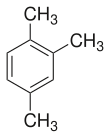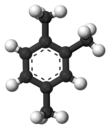1,2,4-Trimethylbenzene
| |||
| Names | |||
|---|---|---|---|
| Preferred IUPAC name
1,2,4-Trimethylbenzene | |||
| Other names
Pseudocumene,
Asymmetrical trimethylbenzene, ψ-Cumene | |||
| Identifiers | |||
3D model (JSmol)
|
|||
| 1903005 | |||
| ChEBI | |||
| ChEMBL | |||
| ChemSpider | |||
| ECHA InfoCard | 100.002.216 | ||
| EC Number |
| ||
| KEGG | |||
PubChem CID
|
|||
| RTECS number |
| ||
| UNII | |||
| UN number | 1993 2325 | ||
CompTox Dashboard (EPA)
|
|||
| |||
| |||
| Properties | |||
| C9H12 | |||
| Molar mass | 120.19 g/mol | ||
| Appearance | Colorless liquid | ||
| Density | 0.8761 g/cm3 | ||
| Melting point | −43.78 °C (−46.80 °F; 229.37 K) | ||
| Boiling point | 169 to 171 °C (336 to 340 °F; 442 to 444 K) | ||
| -101.6·10−6 cm3/mol | |||
| Hazards | |||
| GHS labelling: | |||
  
| |||
| Warning | |||
| H226, H315, H319, H332, H335, H411 | |||
| P210, P233, P240, P241, P242, P243, P261, P264, P271, P273, P280, P302+P352, P303+P361+P353, P304+P312, P304+P340, P305+P351+P338, P312, P321, P332+P313, P337+P313, P362, P370+P378, P391, P403+P233, P403+P235, P405, P501 | |||
| Flash point | 44.4 °C (111.9 °F; 317.5 K) | ||
| Explosive limits | 0.9%–6.4%[2] | ||
| NIOSH (US health exposure limits): | |||
PEL (Permissible)
|
none[2] | ||
| Safety data sheet (SDS) | Sigma-Aldrich MSDS | ||
| Related compounds | |||
Related compounds
|
1,2,3-Trimethylbenzene; 1,3,5-Trimethylbenzene | ||
Except where otherwise noted, data are given for materials in their standard state (at 25 °C [77 °F], 100 kPa).
| |||
1,2,4-Trimethylbenzene, also known as pseudocumene, is an organic compound with the chemical formula C6H3(CH3)3. Classified as an aromatic hydrocarbon, it is a flammable colorless liquid with a strong odor. It is nearly insoluble in water but soluble in organic solvents. It occurs naturally in coal tar and petroleum (about 3%). It is one of the three isomers of trimethylbenzene.
History
[edit]In 1849, Charles Blachford Mansfield rectified coal tar and identified fractions which he hypothesized to be cumole and cymole. The latter fraction boiled slightly above 170°C and had specific density of 0.857.[3]
In 1862, Warren De la Rue and Hugo Müller (1833-1915) proposed the term pseudocumole for the fractions heavier than xylole.[4]
When three years later American chemist Cyrus Warren (1824-1891) attempted to reproduce Mansfield's results, he determined that the oil boiling at 170° has the same formula as cumole, not cymole, and suggested to name it isocumole.[5]
The structure of the compound was determined by Th. Ernst and Wilhelm Rudolph Fittig, who first prepared it from bromoxylene and iodomethane in 1866 by a Wurtz–Fittig reaction developed two years earlier.[6]
In the next year, Fittig et al. adopted the pseudocumol terminology,[7] in 1869 Fittig and B. Wackenroder proved that the fraction is a mixture of mesitylene with another trimethylbenzene, for which the name of pseudocumol was retained,[8] and in 1886 Oscar Jacobsen showed that the third trimethylbenzene he discovered earlier is also present.[9]
Production
[edit]Industrially, it is isolated from the C9 aromatic hydrocarbon fraction during petroleum distillation. Approximately 40% of this fraction is 1,2,4-trimethylbenzene. It is also generated by methylation of toluene and xylenes and the disproportionation of xylene over aluminosilicate catalysts.[10]
Uses
[edit]Pseudocumene is a precursor to mellitic anhydride, from which high performance polymers are made. It is also used as a sterilizing agent and in the making of dyes, perfumes and resins. Another use is as an antiknock agent,[11] since its research and motor octane numbers are well above 100.[12]: Fig. II.1 [13]
In automobile fuel it is a minor additive, with its share in US gasoline rising from 0.03–0.5% in early 1990s[14] to 1.1–2.6% in 2011.[15] It may be a major component of some avgas formulations.[16]
Scintillator
[edit]1,2,4-Trimethylbenzene dissolved in mineral oil is used as a liquid scintillator[17] in particle physics experiments such as NOνA and Borexino.
See also
[edit]References
[edit]- ^ Merck Index, 11th Edition, 7929
- ^ a b NIOSH Pocket Guide to Chemical Hazards. "#0638". National Institute for Occupational Safety and Health (NIOSH).
- ^ Mansfield, Charles Blachford (1849). "Researches on coal tar". Quarterly Journal of the Chemical Society of London. 1 (3): 244–268. doi:10.1039/QJ8490100244. ISSN 1743-6893.
- ^ DeLaRue, Warren; Müller, Hugo (1862). "On some products of the action of dilute nitric acid on some hydrocarbons of the benzol series. (Preliminary notice.)". Quarterly Journal of the Chemical Society of London. 14 (1): 54–57. doi:10.1039/QJ8621400054. ISSN 1743-6893.
- ^ The American Journal of Science and Arts. S. Converse. 1865.
- ^ Ernst, Th.; Fittig, Rud. (1866). "Ueber das Methyl‐ und Aethylxylol". Justus Liebigs Annalen der Chemie. 139 (2): 184–198. doi:10.1002/jlac.18661390208. ISSN 0075-4617.
- ^ Fitig, Rud.; Köbrich, A.; Jilke, T. (1868). "Ueber die Zersetzung des Camphers durch schmelzendes Chlorzink". Justus Liebigs Annalen der Chemie. 145 (2): 129–157. doi:10.1002/jlac.18681450202. ISSN 0075-4617.
- ^ Fittig, Rud.; Wackenroder, B. (1869). "Ueber das im Steinkohlentheer enthaltene Trimethylbenzol". Justus Liebigs Annalen der Chemie. 151 (3): 292–298. doi:10.1002/jlac.18691510304. ISSN 0075-4617.
- ^ Jacobsen, Oscar (1886). "Beitrag zur Kenntniss der zwischen 170 und 200° siedenden Kohlenwasserstoffe des Steinkohlentheeröls". Berichte der deutschen chemischen Gesellschaft. 19 (2): 2511–2515. doi:10.1002/cber.188601902195. ISSN 0365-9496.
- ^ Karl Griesbaum, Arno Behr, Dieter Biedenkapp, Heinz-Werner Voges, Dorothea Garbe, Christian Paetz, Gerd Collin, Dieter Mayer, Hartmut Höke "Hydrocarbons" in Ullmann's Encyclopedia of Industrial Chemistry 2002 Wiley-VCH, Weinheim. doi:10.1002/14356007.a13_227
- ^ "Chemical Summary for 1,2,4-Trimethylbenzene". United States Environmental Protection Agency. 1994-08-01. Archived from the original (text) on 18 June 2008. Retrieved 2008-01-28.
- ^ Scherzer, Julius (1990). Octane-Enhancing Zeolitic FCC Catalysts: Scientific and Technical Aspects. CRC Press. p. 10. ISBN 978-0-8247-8399-0.
- ^ Simanzhenkov, V.; Idem, R. (2003). Crude Oil Chemistry. CRC Press. p. 41. ISBN 978-0-203-01404-2. Retrieved 27 December 2024.
- ^ Doskey, Paul V.; Porter, Joseph A.; Scheff, Peter A. (November 1992). "Source Fingerprints for Volatile Non-Methane Hydrocarbons". Journal of the Air & Waste Management Association. 42 (11): 1437–1445. doi:10.1080/10473289.1992.10467090. ISSN 1047-3289.
- ^ "Hydrocarbon Composition of Gasoline Vapor Emissions from Enclosed Fuel Tanks". nepis.epa.gov. United States Environmental Protection Agency. 2011.
- ^ U.S. patent 9593285B2
- ^ Mufson, S.; et al. (November 1, 2015). "Liquid scintillator production for the NOvA experiment". Nuclear Instruments and Methods A. 799: 1–9. arXiv:1504.04035. Bibcode:2015NIMPA.799....1M. doi:10.1016/j.nima.2015.07.026. S2CID 118578183.


